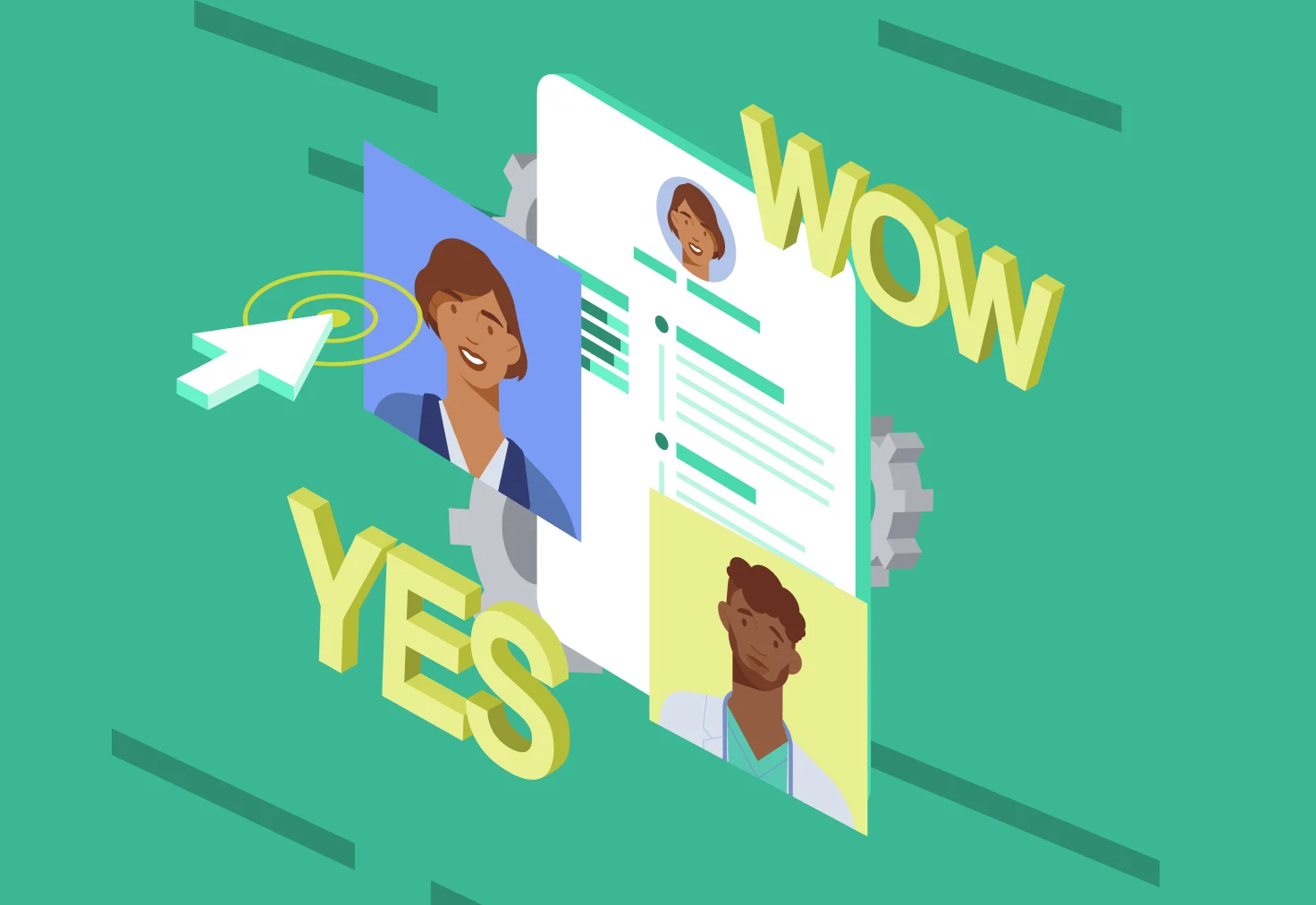It’s no secret that everyone wants their resume to be noticed, but not everyone knows how to make this happen. One of the best ways to boost your chances of being spotted is to have an eye-catching resume header.
While you may think you need to hire a designer to make your resume stand out, that’s not really the case. Surely, a design that is pleasing to the eye will play its part. However, what matters most is what you include in your creative resume heading.
If you’re unsure what a resume heading is, read on. We’re going to guide you through the process of creating a captivating one and help you be noticed!
Key Takeaways
A header is the first thing hiring staff notices on your resume. To grab their attention and make them continue reading it, a header should be prominent and contain all the necessary information.
A resume header serves as a business card whose purpose is to introduce you. Thus, it should include information such as your full name, job title, contact information, location, and specific social media profiles.
When crafting a resume header, it’s essential to keep its format in mind and add all the information in the proper order.
Listing specific social media profiles can help enhance your resume. Yet, it’s necessary to be aware of what you should and should not include.
What is a Resume Header & Why It’s Important
A resume header refers to the first section of your resume or application document.
Being located at the top, a resume header is the very first thing a recruiter or hiring manager sees. It acts as a general introduction to you as a candidate, so it should include all the significant information that lets a recruiter or hiring manager get in touch with you.
A resume heading enables recruiters or hiring managers, as well as ATS (applicant tracking software), to scan your details and reach out to you to schedule an interview. A poorly formatted heading may even mess with the ATS software or discourage recruiters from contacting you.
Hiring staff scans resumes quickly—on average, they spend only 7.4 seconds on each. So, if your CV or resume fails to catch their eye, you will not be invited for the interview.
What Goes on a Resume Header
Think of a resume header as your business card that enables people to get in touch with you. The typical information you should list includes your name, contact information, and, depending on the title, websites, and social media profiles.
But even though you’re expected to include some basic information about yourself in the heading, there is a possibility of including something that really doesn’t belong there.
To avoid adding something that shouldn’t be on your resume header, follow the list below.
#1. Name
Always state your full name. No matter how keen you are on your nickname, stay away from including it.
In addition, make sure that the name you put on social media profiles that you share with a recruiter matches the one on a resume header.
#2. Job Title
This one is fairly obvious, but you still should be careful with the job title you add here. Some positions that involve almost the same duties and responsibilities may be called differently. Thus, always mention the word-for-word title given in the job ad.
#3. Contact Information
Your phone number and email address are the key means of communication between you and a recruiter.
Always list the phone you use most and never the work number. Add the country code in case you’re applying for a remote position outside your country.
Being funny and creating an email address after your favorite game or cartoon character is fine if you’re going to use it with your friends. For a more professional environment, you’ll need a professional email that is easy to read.
The standard is to create an email with your first name and last name. In case it’s taken, you can use the first or last initial or figures that are somehow related to you.
#4. Social Media
You should be very careful with listing social media in your resume header. You want to share content that is related to your vocation or position. Being a professional network, LinkedIn is ideal for this.
However, this is not the case with Instagram, Facebook, or TikTok, where you share personal stuff. Yet, if you insist on listing your social media profiles, make your profiles private. You don’t want a recruiter to see you partying hard all night or ranting about the current economic or political situation.
#5. Location
No, you don’t need to share your actual location in terms of your home address; your city and country of residence would be enough.
Recruiters or hiring managers typically prefer people who live in the same or nearby city where the company is. If you’re open to relocation and wouldn’t mind moving to another city, feel free to state so.
#6. Optional—Summary/Objective
A summary or objective can also be included in your resume header. With these two optional sections, a recruiter and hiring manager may conclude what you’re like and why you may be a good fit for the position.
A resume summary sums up your work experience and demonstrates how it can be beneficial for the company you’d like to work for.
A resume objective, on the other hand, illustrates your professional goals. It doesn’t involve previous experience, so it’s ideal to be included in a resume header for a fresher with no experience or for a person seeking a career change.
How to Format Resume Header
The resume header should be located at the top of the page, in the center, or in the left margin. There are several things to keep in mind when formatting it, including the following:
Resume Header Format
Readability: Don’t use overly complex language; stick to simple sentence structures and language instead.
Conciseness: Make sure that your header is short, ideally containing 50 words or less. If you decide to include a summary or objective, keep it brief, too.
Design: The rest of the resume should be quite simple, but with the header, you can unleash your creativity. You can play around with different colors, layouts, styles, and fonts (as long as they are professional and intelligible) instead of going for a plain header.
Your name is the only thing that will set you apart from the others, so make it stand out.
List your title, phone number, and email after your full name. Your name should be in the first line, and your title right below it. Next, you can list your phone number and email in the same line. If you want to include a summary or objective, add it below your contact information.
In terms of resume header font size and type, choose anything that is clear and easy to read. Regarding the size, the font shouldn’t be smaller than 10 or bigger than 12 points. Some of the most suitable ones include (but are not limited to) Calibri, Cambria, Helvetica, Georgia, and Gill Sans.
How to Enhance Your Resume Header With Social Media
Listing your name, job title, and basic contact information in your resume header is standard. However, tweaking it with a few relevant social media profiles may help it stand out from the piles of other resumes.
Here are a few additions you could include to enhance your resume header:
#1. LinkedIn
Almost all recruiters are on LinkedIn. Listing your URL will let the hiring staff find out more about your working experience and qualifications.
#2. GitHub
If you are a software engineer, web developer, or computer scientist, GutHub is a valuable resource to include. Many developers upload their projects to GitHub for others to see. If you’re one of them, link your profile to your resume.
#3. Twitter
Including Twitter can be a double-edged sword. If you use the network professionally in a way that pertains to and is relevant to your position, don’t shy away from listing it.
However, if you use it to stan, rant, vent, criticize, and share opinions that are unrelated to your job, it wouldn’t be wise to include it.
#4. Quora
Are you an active participant in a specific field on Quora with numerous followers? Go ahead and list your profile in your resume header.
This could persuade the hiring manager or recruiter that you really are an expert in your field.
#5. Behance
Just as is the case with Twitter, relevance is a key factor here. If you are applying for a graphic designer or content creator position and have a portfolio on Behance, don’t hesitate to include it.
However, if graphic design is your hobby and you’re applying for an unrelated position, listing Behance wouldn’t do much service.
#6. Personal Blog or Website
If you keep a blog or have a website that is related to your position, feel free to list it in your resume header. However, make sure that you don’t have anything too personal that might get you into trouble.
What Not to Include in a Resume Header
Besides social media profiles not pertaining to your job or industry, unprofessional email, and nicknames, there are specific things you should exclude from your resume header. Though hiring staff regard including this information as a grave mistake, job hunters keep making it.
Here’s the list of things you should leave off your resume header:
What Not To Include
Profile photo/headshot
Age
Gender and pronouns
Sexual orientation
Marital status
Religious or political affiliations
Nationality
Full home address
Multiple phone numbers
Buzzwords such as ninja, guru, samurai, etc.
Oddly enough, the list of things to include in or exclude from your resume may vary between different continents. For instance, in Asia (Malaysia or China), you are required to add a profile photo, along with personal information such as your date of birth or marital status.
On the other hand, in the UK, US, and Australia, the inclusion of sensitive information like age, gender, and marital status is discouraged. The same applies to a profile photo in order to avoid discrimination. Including these details in Europe, however, is pretty common.
Lastly, job seekers in the US unleash their creativity to make their resumes and resume headers colorful and original. In the UK, however, the desired format is mostly plain.
Resume Header Examples
If you’re unsure of how to format it, here are some resume header ideas.
This is what a good one should look like:



And this is what a bad resume heading looks like:

Key Takeaways
A resume header is just like a book cover—its purpose is to grab the attention of someone looking at it. If it fails, no one will be interested in reading it.
As a consequence, a recruiter won’t invite you for an interview, and you will miss an exquisite job opportunity. Therefore, these headings should not be taken for granted.
While you may be tempted to list all the information about you, some things should be left off. Adding social media profiles, a personal blog, or a website is fine as long as it’s job-related. If it’s not, it’s advisable that you list contact information only.
Unleash your creativity and make your heading stand out, as your goal is to be noticed. But don’t overdo it, as your resume may end up looking messy and unreadable.


